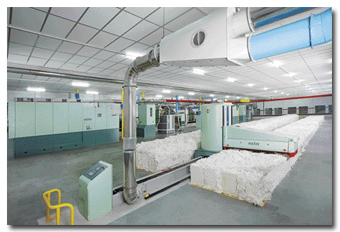When spinners returned to work after the July 4 holiday, they were met with a rather unpleasant
surprise: the business that had been so robust for the previous 18 months had dwindled to a
trickle.
“We saw signs that this might happen a bit earlier,” said one spinner, “but we were hoping
to avoid the extended downturns that have occurred after similar periods of brisk business.”
Indeed, from reports across various markets and specialties, the slowdown in new orders was
relatively short-lived. “In fact, business has picked up substantially in just the past few weeks,
especially in specialty yarns,” another spinner said in early September. Orders for commodity yarn
are still behind where they were a few months ago, he said, but are showing some signs of
resurgence.
Reasons For The Slowdown
Spinners attribute the short-term drop in business to multiple factors. Inventory
adjustment, increasing product flow from foreign suppliers and customer pricing concerns were the
most frequently mentioned contributors.
“I have to believe, from my observations, that the drop-off was primarily a result of
inventory adjustment,” said one spinner. “I think a lot of customers perhaps overbought in the
early part of the year, for a variety of reasons, and were trying to get rid of excess inventory
before placing additional orders. Now, it looks like that situation has stabilized, and orders are
starting to come in again.”
An observer close to the industry commented: “The slowdown in the economy around the middle
of the year certainly had some impact. In those conditions, certainly nobody was going to get
caught carrying a lot of high-priced inventory, or even any inventory at all.”
Another spinner observed: “A lot of the product that was produced in the first half of the
year, through July 4, was through long-term orders in which customers had the cotton price fixed at
about 90 cents per pound or so. They didn’t fix anything after that because the price of cotton was
ramping up so fast and they were waiting for it to come back down. There was a lot of concern that
customers were front-loading inventory and that the world would shut down in the second half. Some
of the denim people, for example, were worried that there wouldn’t be anything at all after
mid-year. And that hasn’t happened. It slowed down, but there was not this massive falloff.”
Added a yarn buyer: “There was certainly a disruption in the market from the flood of
low-cost products from Asia. Companies in India, for example, went from exporting virtually nothing
for an extended period of time to shipping a tremendous amount of product over a very short period
of time. They had abandoned their supply chains and had to ‘buy’ their way back in. They were
selling yarn below where the rest of the world saw their cotton prices. That had to get absorbed by
the market, and it took a little while for that to happen.”
Continuing Pricing Issues
Pricing continues to be a significant issue for most spinners. “It’s tough when customers
look at the price for new cotton and see it around $1.05 or $1.07 a pound and the mills are still
sitting on some $1.60 or $1.70 cotton. There’s a lot of pressure to reduce prices.”
As of September 2, the price for the base quality of cotton in the seven designated markets
measured by the U.S. Department of Agriculture averaged $1.0271 per pound, continuing the downward
spiral that began near the end of the first quarter. As recently as March, spot prices were more
than $1.80 per pound.
“With the volatility of prices, there is a limit to what mills can do,” said a yarn broker.
“I think over the next few months — especially until we get some amount of equalization between the
cost of our raw materials and the perceived market price for our product — there is going to have
to be some give and take from both mills and customers.”
Another spinner agreed: “When the price of cotton began increasing dramatically, mills and
their customers had to work at agreeing to price increases on an incremental basis. Customers were
not willing to accept price increases that tracked the cotton futures market. Now that prices are
falling, the same thing is going to have to happen in reverse. Customers want lower prices, but
they are going to have to accept price decreases in stages.”
September/October 2011





